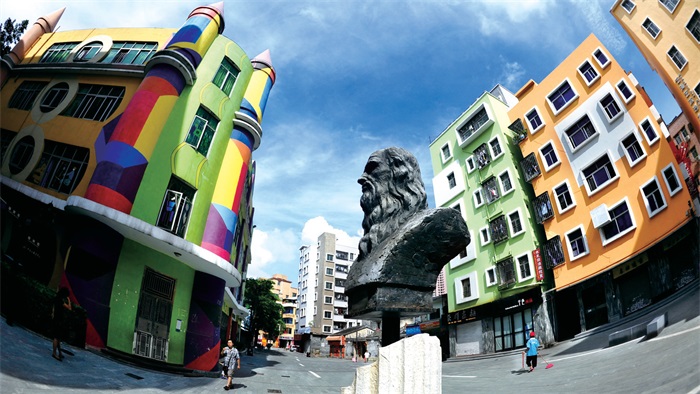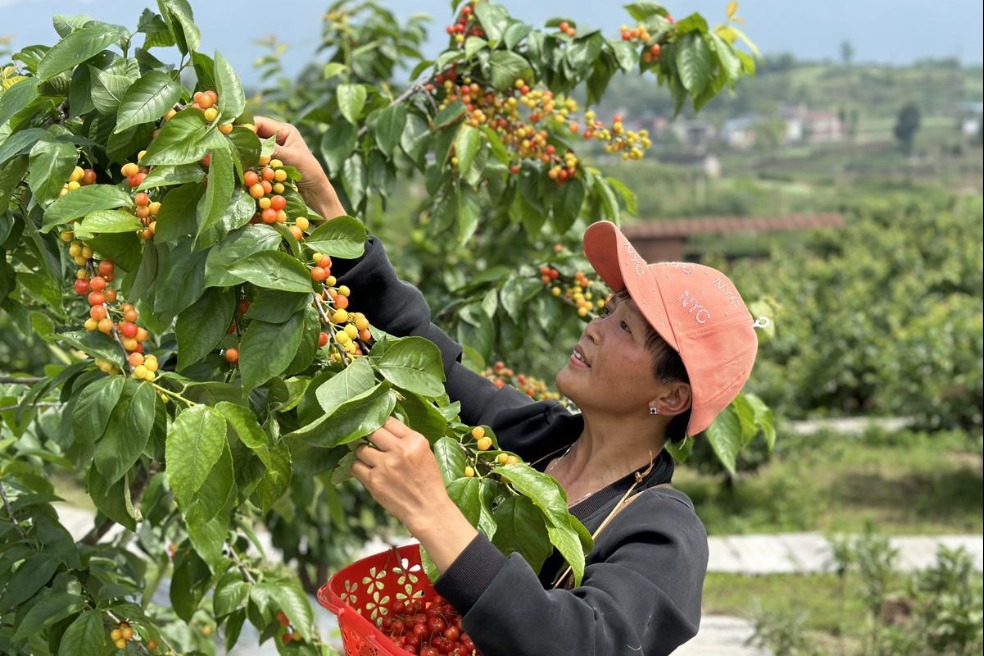From 'copycat kingdom' to cultural icon


Shenzhen's Dafen village has come of age — from a sleepy backwater to a world famous oil painting pivot
Wong Kong takes out a photo from the drawer of his desk. On it, some 20 people — most seemingly in their 20s or younger — pose in front of a tourist site, looking close to each other.
He points to a young man in the middle. "That's me," says Wong with a big grin on his face, reminiscing the early days he had spent with his "apprentices", as he calls them, in Dafen village.
Wong, 73, is an art dealer from Hong Kong. He was the first person to go to Dafen to start his oil painting business. It was 1989 when he arrived there, hiring the first 26 "apprentices" to do oil painting works for overseas clients.
The village, in Shenzhen's eastern Longgang district, was an impoverished rural area back then, with a population of 300 or so. Local villagers lived on rice-growing, earning an annual income of less than 300 yuan ($45) per capita.
Today, Dafen has become a world-renowned oil painting gathering area, hosting around 8,000 workers in the sector. Covering a core area of 0.4 square kilometers, it's not only the largest base for the production and trading of commercial oil paintings in the country, but also an important oil painting trading hub globally.
Last year, 4.15 billion yuan worth of business was sealed in the village-in-city, with half of it coming from overseas sales.
The development shows how Shenzhen's open market environment, thanks to the national policy of reform and opening-up launched in 1978, has helped raise Dafen from a place little known to the outside world to one that shines on the international stage.
Designated as China's first special economic zone, Shenzhen was entitled to enjoy more market-oriented and flexible economic policies.
"The reform and opening-up policy opened a door for Dafen painters to get access to the big international market," said Liu Yajing, director of the Dafen Management Office. "Thanks to the policy, the village was able to gain a big market share in global oil painting production and trade."
According to media reports, Dafen accounted for 60 percent of the global oil painting market at its peak. Its oil painting trade had started from a low level. At the time, the main work for local painters was imitating and reproducing masterpieces. Few of them created works of their own. The replicas were transported overseas for use in hotels, restaurants and families in Western countries.
One of Wong's clients was United States retail giant Walmart. At first, he says, Walmart ordered 6,000 oil paintings from him. Then, the orders grew bigger.
"The supermarket asked for more than 100,000 pieces a month," he says. "Such a large number, you see. I needed to find a production base."
As Hong Kong's labor and housing costs soared, Wong headed north, spotting Dafen village in Shenzhen. "For a 250-square-meter house in Dafen, the monthly rent was only 1,600 yuan in the early 1990s," he recalls.
Sometimes, he would get more than 300,000 pieces ordered by Walmart and other foreign clients, and he had to complete the work in one month.
"At peak periods, I had to hire over 3,000 apprentices to work for me. It was like an assembly line, where one worker was in charge of a specific part of an art piece," says Wong.
In return, they were well paid. A painter surnamed Liao says she could earn more than 2,000 yuan a month when business was good in 1992, compared with the average monthly income of just less than 500 yuan for local workers at the time.
Imitator to creator
But, it was not a stable situation. In fact, life for Dafen painters was fraught with uncertainties. Sometimes, big orders would come, sometimes nothing at all. Still, more and more people from across the country came.
Jiang Qingbei is one of them. The 64-year-old still remembers the time 15 years ago when he made a bold decision to give up his decent life in the northeastern city of Shenyang, Liaoning province, and embark on an unpredictable adventure in Dafen.
Jiang used to work at an art company in Shenyang, where he earned 5,000 yuan a month back in 2000, while the average monthly wage for the city's residents was below 600 yuan.
"Life as an independent artist in Dafen was entirely different. No stable income. You had to bear the pressure of not being able to sell a single piece for several months," says Jiang.
"But, you had a strong feeling that it's a place where you can totally immerse yourself in art because all others around you are doing the same thing. That is something most attractive to an artist and something you cannot find elsewhere."
Jiang was one of the few painters who produced original artworks in Dafen in the early 2000s.
"When I first arrived in Dafen in 2003, there were only about 10 painters producing original pieces. Some found it embarrassing to admit they were from Dafen because it was widely seen as a copycat kingdom," he laments.
Reliance on low-skilled work was risky and made them vulnerable to macroeconomic changes.
The painters paid the price in 2008 when the global financial crisis erupted. Overseas oil painting orders plunged 30 percent, resulting in a large number of painters struggling to keep their heads above the water.
They then began the process of transformation, turning their focus from overseas markets to the domestic market, and striving to enrich their skills in creating original works.
The Shenzhen government offered help by organizing trips to various places for local painters to make art production and providing opportunities for international exchanges.
The efforts have paid off. Now, Dafen hosts nearly 300 artists who produce and sell their own pieces. And the number keeps rising.
The type of art in the village has also expanded from oil paintings to traditional Chinese cultural items, such as traditional Chinese paintings, calligraphic works, seal cuttings, embroideries, as well as other art works like art crafts and abstract art items.
Having transformed itself from an "imitator" to a "creator", Dafen has reached a new stage, poised to make a major contribution to cultural integration among countries and regions in the Belt and Road Initiative.
The Shenzhen authorities are pushing forward with a plan to turn Dafen into an internationalized art base, with the aim of attracting overseas artists to make art production there and promoting international exchanges.
"We hope to turn Dafen into a cultural landmark that represents Shenzhen's image as an international city," said Liu. "It will emerge as an art town that includes exhibitions, trade, sightseeing and entertainment in future."
The B&R Initiative is expected to boost Dafen's internationalization process by facilitating a wider market for global cultural trade.
In the past, the US and Europe were the main markets for Dafen's painters.
With the B&R Initiative, a wider international market covering Central Asia, South Asia, Southeast Asia and Africa will open up for local painters, fueling further growth for the oil painting village.
Liu said more than 300 domestic and overseas groups visited Dafen village last year, many of which were from the B&R countries.
"The countries have their own intangible cultural heritage. They are very interested in taking their cultural resources to Dafen. With an open and inclusive gene, Dafen highly welcomes the integration and hopes to serve as a platform for B&R artworks," she said.
As Dafen village evolves into a higher level and seeks new growth engines, industry insiders believe the key lies in integrating technology with the traditional cultural industry.
Technology will be the driving force for Dafen village to achieve further growth, said Zhou Feng, head of the Dafen Fine Art Industry Association.
"At present, many Dafen painters are already taking advantage of high-tech to boost their business, such as opening online shops," he said, noting that the painters are now running 1,700 online shops on Tmall, JD and other e-commerce platforms.
"But, in terms of integrating high-tech into artworks to create innovative pieces, there's still a long way to go. This is a trend that offers unlimited prospects," Zhou said.
- Action taken over Chongqing Gas Group overcharging
- Xi: Crucial role for new PLA force
- Obesity, myopia growing issues among youth
- Shanghai Coffee Culture Festival celebrates local coffee culture
- Developing Cyberspace Force crucial for network protection
- Thunderstorm delays flights at Guangzhou Baiyun International Airport



































